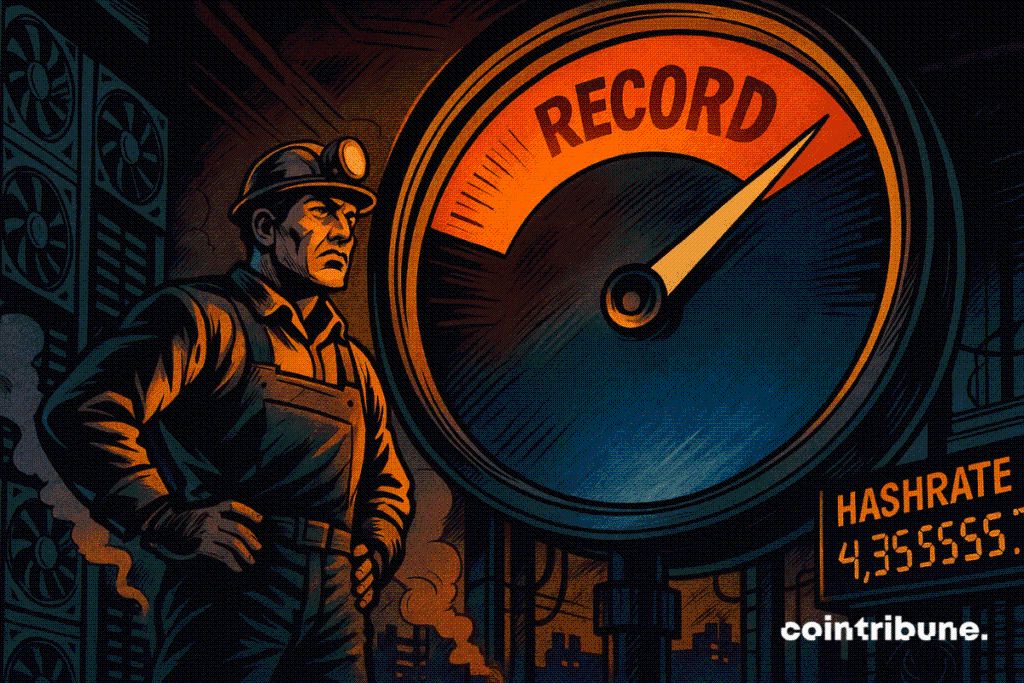Bitcoin Loses 76 EH/s In Just Four Days
In a few days, one of the key indicators of the robustness of the Bitcoin network experienced a striking turnaround. On August 8, the hashrate reached a historic peak before declining sharply, a sign of a sudden adjustment in the computing power mobilized to secure the blockchain. This reversal, occurring while BTC still hovers near its annual highs, rekindles debates on the balance between technical performance and economic constraints for mining specialists.

In brief
- On August 8, 2025, Bitcoin hashrate reached a historic record of 976 EH/s before declining to around 900 EH/s in four days.
- This decline coincides with a 1.42 % increase in mining difficulty, weighing on miners’ profitability despite a high BTC price.
- The slowdown in production rate increases the average block time to 11 minutes and 4 seconds, above the 10-minute target.
- A difficulty adjustment, scheduled for August 24, 2025, could ease pressure on miners and reactivate machines on standby.
A record followed by a marked hashrate decline
On August 8, 2025, the Bitcoin network reached an unprecedented computing power, peaking at 976 exahashes per second (EH/s) according to the seven-day moving average.
Four days later, this level contracted to around 900 EH/s, a decrease of 76 EH/s, while massive purchases strengthen the crypto price . This decline coincides with a 1.42 % increase in difficulty at block number 909216.
According to hashrateindex.com data :
- The hashprice was $57.30/PH/s at the time of the record ;
- It increased to $58.76/PH/s, a +2.55 % rise ;
- On August 11, with BTC above $120,000, it reached $59.78/PH/s ;
- This revenue remains 4.72 % lower than the level on July 14 ($61.67/PH/s).
Analysts point to the difficulty increase as the main factor behind the hashrate decline, a situation where operational profitability is squeezed despite a favorable BTC price .
This gap between hashprice progression and power withdrawal reflects a tense context. Mining specialists face high operating costs, and the slightest difficulty variation can tip the economic balance of some farms.
Mining-related difficulties
Since this hashrate decline , block production rate has slowed, with a current average of 11 minutes and 4 seconds per block, against a theoretical target of ten minutes.
This lengthening suggests a temporary imbalance between difficulty and active computing power on the network. Current projections indicate that at the next difficulty adjustment, scheduled for August 24, it could decrease by 9.64% if the trend continues.
Such a decrease would ease the burden on mining companies and might encourage some to bring standby equipment back online, helping to stabilize block pace. This development would also create an opportunity window for players with competitive energy costs, who could increase their market share in the short term.
If the price of the leading crypto remains high, the positive impact of reduced difficulty on profitability could consolidate mining activity, whose revenues exploded to $1.66 billion in July . Conversely, a trend reversal in the spot market would weaken the less solid operators, possibly accelerating a consolidation movement in the sector. In any case, the August 24 adjustment is a decisive test for the resilience of infrastructures and the ability of mining farms to adapt to a constantly evolving technical environment.